Transportation: The Life of a Westerner in Nepal
 While in Nepal there are plenty of different forms of transportation; consisting of buses, taxis, and tuktuks, carriages, and the occasional elephant! The most common, and cost effective, form of travel is always the local bus system. Naturally, these have a habit of all of which are simultaneously efficient and terrifying. Typically, the rates are anywhere between 15-25 rupees depending on the distance.
While in Nepal there are plenty of different forms of transportation; consisting of buses, taxis, and tuktuks, carriages, and the occasional elephant! The most common, and cost effective, form of travel is always the local bus system. Naturally, these have a habit of all of which are simultaneously efficient and terrifying. Typically, the rates are anywhere between 15-25 rupees depending on the distance.
We quickly found there was a reason the buses were so cost effective. Buses sometimes come with stress, but always promise cramped spaces! Nepal is definitely NOT known for its personal space. This leads to the buses carrying more people than comfortable, let alone safe.
For example, today we were so cramped I felt claustrophobic and light headed. I had a man push my back trying to squeeze us farther into the bus because they wanted to fit more people in. Picture sardines in a can and that’s what we looked and felt like! The moment before he pushed me, I had just becoming tolerant to my current situation and realized I physically couldn’t move further back. Things quickly began to get very stressful. My heart began to race, my vision blurred, and my knees shook. I quickly talked to my group and we got off of the bus before I completely broke down. This post is not meant to sway anyone against the bus system. This was actually the only occurrence in which I felt this uncomfortable. The buses are a way of life in Nepal for the natives and has become a very important travel asset for westerners as well. However, there is a learning curve that you would not quite expect. If you like crowded, hot areas, lack of personal space, ceilings too short to stand under, and have a good sense of adventure, Nepali buses are for you too!
